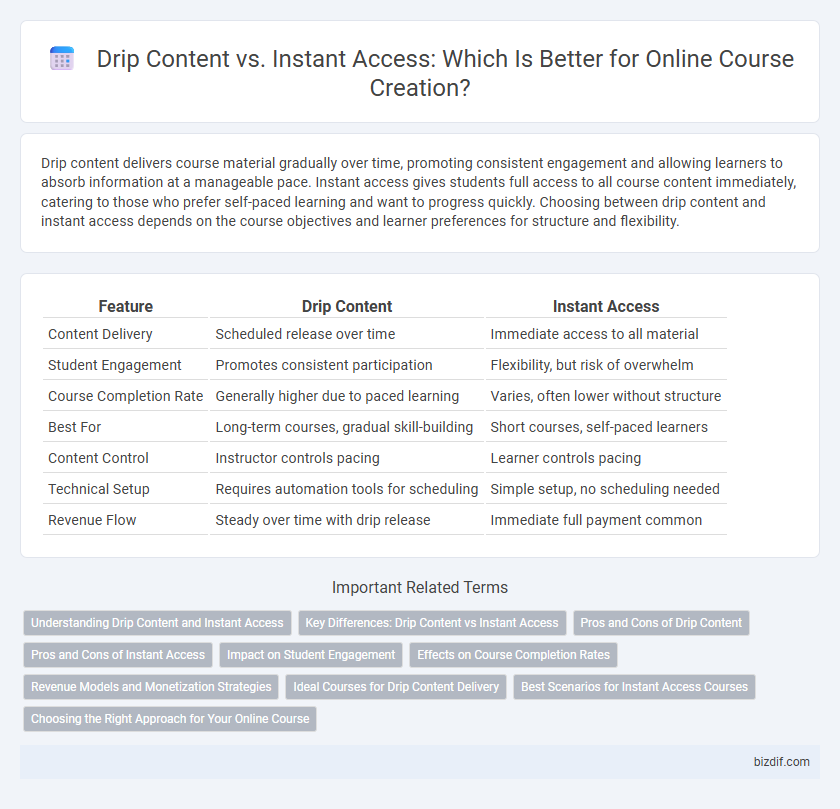Drip content delivers course material gradually over time, promoting consistent engagement and allowing learners to absorb information at a manageable pace. Instant access gives students full access to all course content immediately, catering to those who prefer self-paced learning and want to progress quickly. Choosing between drip content and instant access depends on the course objectives and learner preferences for structure and flexibility.
Table of Comparison
| Feature | Drip Content | Instant Access |
|---|---|---|
| Content Delivery | Scheduled release over time | Immediate access to all material |
| Student Engagement | Promotes consistent participation | Flexibility, but risk of overwhelm |
| Course Completion Rate | Generally higher due to paced learning | Varies, often lower without structure |
| Best For | Long-term courses, gradual skill-building | Short courses, self-paced learners |
| Content Control | Instructor controls pacing | Learner controls pacing |
| Technical Setup | Requires automation tools for scheduling | Simple setup, no scheduling needed |
| Revenue Flow | Steady over time with drip release | Immediate full payment common |
Understanding Drip Content and Instant Access
Drip content delivers course materials incrementally over time, enhancing learner retention and engagement by pacing information absorption. Instant access grants learners full course content immediately, promoting flexibility and self-paced study but may overwhelm without structured guidance. Choosing between drip content and instant access depends on course goals, learner autonomy, and content complexity.
Key Differences: Drip Content vs Instant Access
Drip content delivers course materials incrementally based on a schedule, enhancing learner engagement and preventing overwhelm, while instant access provides all course materials immediately for self-paced study. Drip content is ideal for fostering long-term retention and structured learning, whereas instant access offers flexibility and caters to motivated learners seeking rapid course completion. Choosing between drip content and instant access depends on course goals, learner preferences, and content complexity.
Pros and Cons of Drip Content
Drip content in online course creation delivers modules incrementally, enhancing learner retention and preventing overwhelm, but it may frustrate students seeking immediate access to all materials. This method encourages continuous engagement and scheduled progress, ideal for courses requiring structured pacing, yet it limits flexibility for self-paced learners. Instructors benefit from controlling content release and reducing content piracy risks, while potentially facing increased management complexity.
Pros and Cons of Instant Access
Instant access to online courses provides learners with the flexibility to consume all content at their own pace, enhancing motivation and enabling immediate application of knowledge. However, this approach may lead to overwhelm or cramming, reducing long-term retention and increasing the risk of course abandonment. While instant access supports self-directed learning, it requires strong learner discipline and effective time management to maximize outcomes.
Impact on Student Engagement
Drip content, by releasing lessons gradually, maintains consistent student engagement and encourages steady progress through carefully timed delivery. Instant access allows learners to control their pace, fostering independence but risking overwhelming users with excessive information at once. Choosing between drip content and instant access impacts student motivation and retention by balancing structured guidance against flexible learning autonomy.
Effects on Course Completion Rates
Drip content, which releases course material gradually over time, can improve course completion rates by preventing overwhelm and encouraging consistent engagement. Instant access allows learners to consume content at their own pace, but may lead to procrastination and lower completion rates due to lack of structured deadlines. Studies indicate drip-fed courses often yield higher completion rates by fostering regular interaction and sustained motivation.
Revenue Models and Monetization Strategies
Drip content enables course creators to generate steady revenue streams by gradually releasing material, encouraging sustained subscriptions and higher retention rates. Instant access appeals to customers seeking immediate value, often supporting one-time purchase models that maximize upfront cash flow. Combining both approaches can optimize monetization strategies by balancing predictable income with substantial initial sales.
Ideal Courses for Drip Content Delivery
Drip content delivery is ideal for courses with complex subjects requiring gradual knowledge buildup, such as language learning, professional development, or certification programs. This method enhances student retention by releasing material in scheduled intervals, promoting consistent engagement and reducing overwhelm. Instant access suits courses designed for quick consumption or flexible pacing, but drip content optimizes learning outcomes where structured progression is critical.
Best Scenarios for Instant Access Courses
Instant access courses are ideal for learners seeking immediate knowledge application, such as professionals needing rapid upskilling or entrepreneurs launching projects. This format suits content that benefits from self-paced exploration without waiting periods, like coding bootcamps or design tutorials. Providing full course availability enhances motivation and accommodates flexible schedules, increasing learner completion rates and satisfaction.
Choosing the Right Approach for Your Online Course
Selecting the appropriate content delivery method for your online course significantly impacts learner engagement and retention. Drip content releases modules gradually over time, fostering consistent progress and reduced overwhelm, while instant access allows learners to control their pacing and quickly access all materials. Evaluating your target audience's preferences, course complexity, and desired completion rates helps determine whether drip content or instant access best aligns with your instructional goals.
Drip content vs Instant access Infographic

 bizdif.com
bizdif.com